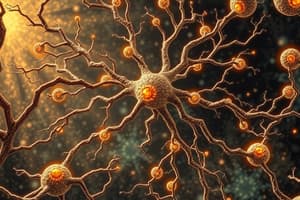Podcast
Questions and Answers
What did Korbinian Brodmann contribute to the study of brain structure?
What did Korbinian Brodmann contribute to the study of brain structure?
- He proposed the neuron doctrine.
- He developed the concept of brain lateralization.
- He discovered the function of neurotransmitters.
- He identified anatomical variations in different brain regions. (correct)
How does Brodmann's work suggest different brain regions have distinct functions?
How does Brodmann's work suggest different brain regions have distinct functions?
- By showing that all regions have identical layering structures.
- By determining that all neurons are the same in structure.
- By proving that brain function is uniform across all areas.
- By identifying different thicknesses of layers in various regions. (correct)
What practical application do Brodmann's areas have in modern neuroscience?
What practical application do Brodmann's areas have in modern neuroscience?
- They help in mapping genetic influences on behavior.
- They are used to classify types of neurotransmitters.
- They are utilized to explain the process of neural regeneration.
- They serve as a navigational tool for identifying brain lesions. (correct)
What is indicated by the different microanatomy found in Brodmann's areas?
What is indicated by the different microanatomy found in Brodmann's areas?
What is a notable aspect of Korbinian Brodmann's research methodology?
What is a notable aspect of Korbinian Brodmann's research methodology?
What distinguishes Homo habilis from Homo erectus?
What distinguishes Homo habilis from Homo erectus?
Which characteristic contributed significantly to the success of Homo erectus?
Which characteristic contributed significantly to the success of Homo erectus?
In terms of physical adaptation, what aspect set Homo erectus apart?
In terms of physical adaptation, what aspect set Homo erectus apart?
What was a likely reason for Homo erectus's widespread migration?
What was a likely reason for Homo erectus's widespread migration?
How does Homo habilis's tool use compare to that of Homo erectus?
How does Homo habilis's tool use compare to that of Homo erectus?
What did Lord Adrian contribute to the field of EEG?
What did Lord Adrian contribute to the field of EEG?
What characteristic is true of pyramidal cells in layer 3?
What characteristic is true of pyramidal cells in layer 3?
Which option describes the significance of EEG in neuroscience?
Which option describes the significance of EEG in neuroscience?
Which of these is NOT a learning objective mentioned in the content?
Which of these is NOT a learning objective mentioned in the content?
What role do neural oscillations play according to the content?
What role do neural oscillations play according to the content?
Which statement accurately describes the neural electrical field?
Which statement accurately describes the neural electrical field?
In which aspect did Hans Berger's work influence modern neuroscience?
In which aspect did Hans Berger's work influence modern neuroscience?
What element is characterized by a difference in charge within a pyramidal cell?
What element is characterized by a difference in charge within a pyramidal cell?
What happens to the theta amplitude when more items are given?
What happens to the theta amplitude when more items are given?
What does alpha reflect in terms of perception?
What does alpha reflect in terms of perception?
Which of the following is true regarding beta waves?
Which of the following is true regarding beta waves?
In what year did Worden et al. conduct their study related to alpha?
In what year did Worden et al. conduct their study related to alpha?
Which statement about theta is correct?
Which statement about theta is correct?
What aspect of cognitive function is associated with alpha waves?
What aspect of cognitive function is associated with alpha waves?
Which of the following best describes the relationship between theta amplitude and item quantity?
Which of the following best describes the relationship between theta amplitude and item quantity?
What is NOT a function associated with beta waves?
What is NOT a function associated with beta waves?
What effect did the injury to Phineas Gage's brain have on his behavior?
What effect did the injury to Phineas Gage's brain have on his behavior?
Which of the following best describes Phineas Gage after his injury?
Which of the following best describes Phineas Gage after his injury?
What does the statement from Dr. John Harlow suggest about Gage's intellectual faculties after the accident?
What does the statement from Dr. John Harlow suggest about Gage's intellectual faculties after the accident?
What characteristic behavior did Phineas Gage display following his injury?
What characteristic behavior did Phineas Gage display following his injury?
Which area of the brain is associated with executive functions and was implicated in Phineas Gage's case?
Which area of the brain is associated with executive functions and was implicated in Phineas Gage's case?
What kind of propensities did Phineas Gage struggle to manage after his injury?
What kind of propensities did Phineas Gage struggle to manage after his injury?
Which of the following best captures the emotional state of Phineas Gage after his accident?
Which of the following best captures the emotional state of Phineas Gage after his accident?
What aspect of Phineas Gage's personality changed to the greatest degree after his accident?
What aspect of Phineas Gage's personality changed to the greatest degree after his accident?
Study Notes
The Neuron Doctrine
- Korbinian Brodmann mapped out the cytoarchitecture of the brain, meaning he looked for anatomical variation across different brain regions.
- Brodmann areas are still used today as a navigational tool, for example, we might refer to a lesion in area 10.
- Brodmann's areas recognized differences in the thickness of brain layers and their distinct microanatomy, implying these regions may have different functions and priorities.
The Electrical Brain
- Hans Berger & EEG (Electroencephalography): Berger discovered that brain waves are measurable using electrical signals – a breakthrough that changed the study of the brain.
- Lord Adrian replicated Berger's findings and acknowledged them as brain activity, making EEG a mainstream method.
- Neural Electrical Field: The positive and negative electric charges across the membrane of pyramidal cells in layer 3, create a measurable electrical field that can be recorded.
THETA & Memory Scanning
- Theta oscillations are associated with memory retrieval.
- When subjects are asked to recall more items, the amplitude of Theta oscillations tends to be higher.
Alpha
- Alpha Oscillations are related to relaxation, and occur mostly when the brain is not actively processing information.
- Worden et al. (2000) researched Alpha Oscillations and sensory perception, indicating a link to sensory processing.
- Alpha Oscillations are associated with temporal resolution in perception, supporting a theory about the brain's temporal processing capabilities.
Beta
- Beta Oscillations appear to be linked to motor tasks.
- Beta Oscillations are more prevalent when people are engaged in cognitive tasks requiring sustained attention.
Dorsolateral & Ventrolateral Prefrontal Cortex
- Dorsolateral prefrontal cortex is located on the top of the frontal lobe and is involved in higher-level cognitive functions such as planning, working memory, and inhibition.
- Ventrolateral prefrontal cortex is found in the bottom part of the frontal lobe and contributes to decision-making, emotion regulation, and impulse control.
Executive Functions
- Executive functions include decision-making, planning, working memory, attention control, and inhibition.
- The dorsolateral prefrontal cortex is primarily responsible for executive functions, thus supporting higher cognitive abilities and goal-directed behavior.
Phineas Gage
- Phineas P. Gage, a railroad worker, survived a traumatic accident where an iron rod pierced his skull and destroyed a significant portion of his prefrontal cortex.
- After the accident, Gage experienced a dramatic change in personality and behavior, becoming impulsive and exhibiting less deference to his peers – highlighting the importance of the prefrontal cortex in regulating social behavior and executive functions.
Hominin Evolution + Homo Habilis & Erectus
- Hominin Evolution: The evolutionary lineage leading to modern humans, characterized by changes in bipedalism, brain size, tool use, and social behavior.
- Homo Habilis ("handy man") appeared around 2.4 million years ago, known for tool use and larger brains compared to earlier hominins.
- Homo Erectus emerged around 1.8 million years ago, exhibited larger brains, controlled use of fire, and had more advanced tools.
- H. Habilis vs. H. Erectus: H. Habilis had a smaller cranial capacity, showed limited tool use, and lacked the advanced fire technology of H. Erectus.
- Why was H. Erectus so successful? H. Erectus was successful due to a combination of factors, including larger brains, controlled use of fire, and advanced tools, all impacting their ability to adapt and thrive in diverse environments.
Studying That Suits You
Use AI to generate personalized quizzes and flashcards to suit your learning preferences.




